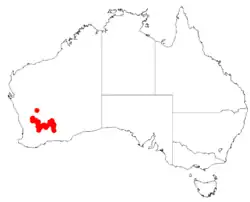Acacia consanguinea
| Acacia consanguinea | |
|---|---|
| Scientific classification | |
| Kingdom: | Plantae |
| Clade: | Tracheophytes |
| Clade: | Angiosperms |
| Clade: | Eudicots |
| Clade: | Rosids |
| Order: | Fabales |
| Family: | Fabaceae |
| Subfamily: | Caesalpinioideae |
| Clade: | Mimosoid clade |
| Genus: | Acacia |
| Species: | A. consanguinea
|
| Binomial name | |
| Acacia consanguinea | |

| |
| Occurrence data from AVH | |
| Synonyms[1] | |
|
Racosperma consanguineum (R.S.Cowan & Maslin) Pedley | |
Acacia consanguinea is a species of flowering plant in the family Fabaceae and is endemic to the south-west of Western Australia. It is a shrub with ascending to erect, straight to curved, terete phyllodes with a curved to hooked tip, spherical heads of golden yellow flowers and glabrous, linear, thinly papery pods.
Description
Acacia consanguinea is a spreading, often rounded shrub that typically grows to a height of 0.4–1.5 m (1 ft 4 in – 4 ft 11 in) and has terete, ash grey branchlets. Its phyllodes are ascending to erect, straight to slightly curved, mostly 20–45 mm (0.79–1.77 in) long and 1.0–1.5 mm (0.039–0.059 in) in diameter, with a curved to hooked tip. There are stipules at the base of the phyllode but that fall off as the phyllodes mature. The flowers are borne in two spherical heads in axils on a peduncle 2–5 mm (0.079–0.197 in) long, each head 4–5 mm (0.16–0.20 in) in diameter with 14 to 29 golden yellow flowers. Flowering occurs in August and September, and the pods are thinly papery, strongly raised on alternating sides and more or less constricted between the seeds, slightly curved and wavy, 30–60 mm (1.2–2.4 in) long and 2.5–3.0 mm (0.098–0.118 in) wide. The seeds are broadly elliptic, about 2 mm (0.079 in) long and glossy with an aril on the end.[2][3][4][5]
Taxonomy
Acacia consanguinea was first formally described in 1995 by Richard Cowan and Bruce Maslin in the journal Nuytsia from specimens collected in 1971 by Maslin, 10 km (6.2 mi) west of Bullabulling towards Caenyie Rock.[6] The specific epithet (consanguinea) means 'related by blood', referring to the species' close relationship with other species of Acacia.[7]
This species belongs to the Acacia fragilis group related to A. fragilis and A. uncinella,[4] in the Section Plurinerves.[8]
Distribution and habitat
This species of wattle is native to the Avon Wheatbelt, Coolgardie and Murchison bioregions of Western Australia where it grows on low rises and plains in sandy or sometimes gravelly soils.[9] Its range extends from around Muntadgin in the west to as far east as Coolgardie, with at least one outlying population found around Wialki much further to the north where it is usually occurs in scrub or heath communities.[4]
See also
References
- ^ a b "Acacia consanguinea". Australian Plant Census. Retrieved 19 July 2025.
- ^ Cowan, Richard S.; Maslin, Bruce R. (1995). "Acacia Miscellany 15. Five groups of microneurous species of Acacia (Leguminosae: Mimosoideae: section Plurinerves), mostly from Western Australia". Nuytsia. 10 (2): 243–244. Retrieved 19 July 2025.
- ^ Cowan, Richard S. Maslin, Bruce R.; Reid, Jordan E. (eds.). "Acacia consanguinea". Flora of Australia. Australian Biological Resources Study, Department of Climate Change, Energy, the Environment and Water: Canberra. Retrieved 19 July 2025.
- ^ a b c "Acacia consanguinea R.S.Cowan & Maslin". Wattle - Acacias of Australia. Lucid Central. Retrieved 21 October 2020.
- ^ "Acacia consanguinea". World Wide Wattle. Retrieved 19 July 2025.
- ^ "Acacia consanguinea". APNI. Retrieved 19 July 2025.
- ^ George, Alex S.; Sharr, Francis A. (2023). Western Australian Plant Names and Their Meanings - A Glossary (fifth ed.). Kardinya: Four Gables Press. p. 171. ISBN 9780645629538.
- ^ "Acacia consanguinea". World Wide Wattle. Retrieved 19 July 2025.
- ^ "Acacia consanguinea". FloraBase. Western Australian Government Department of Biodiversity, Conservation and Attractions.